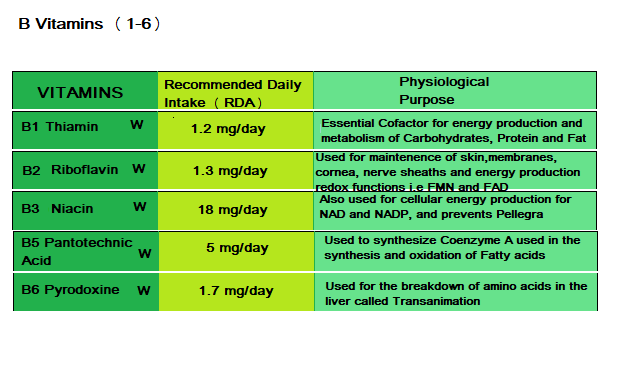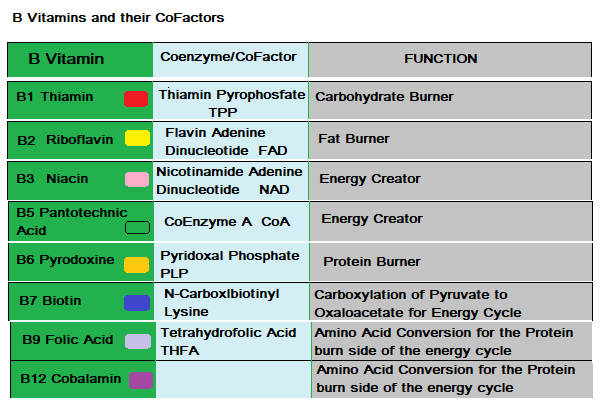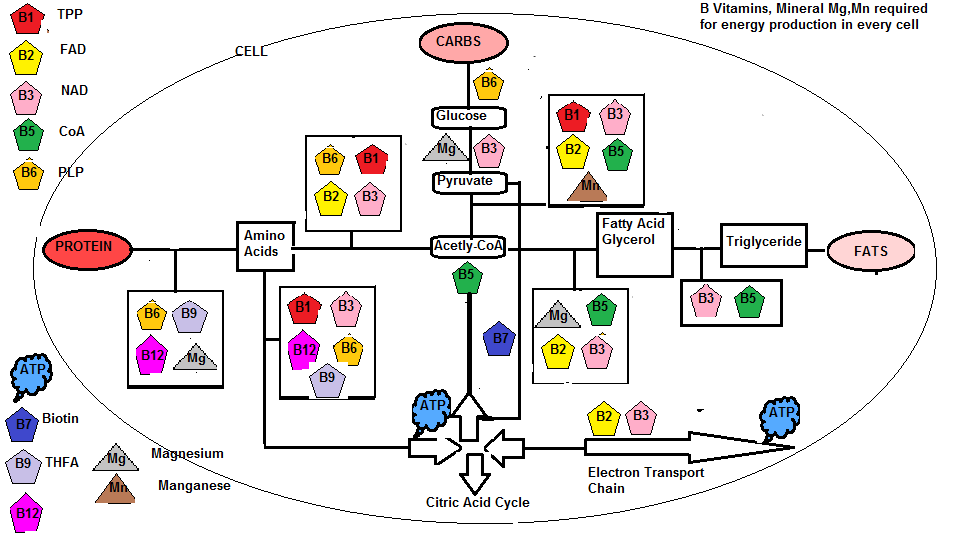These are the vitamins that are discussed in depth in this Part.

The B Vitamins and their Cofactors
The body uses the B complex vitamins as ‘Cofactors’ or ‘Coenzymes’ acting as a chemical substance to activate an inactive enzyme:
 Without enzymes the essential biochemical reactions in the body would be too slow and we would all be walking around like the walking dead (as in people that have what conventional medicine refer to as Chronic fatigue syndrome which generally is a deficiency in B vitamins that are insufficient to derive energy for the host).
Without enzymes the essential biochemical reactions in the body would be too slow and we would all be walking around like the walking dead (as in people that have what conventional medicine refer to as Chronic fatigue syndrome which generally is a deficiency in B vitamins that are insufficient to derive energy for the host).
Enzymes act as catalysts to speed up the huge amount of chemical reactions necessary to sustain life.
One of the major functions of the Vitamin B complex is to assist as ‘cofactors’ for energy metabolism and enable us to burn the fuel intake (Carbohydrates,Fats (Triglycerides) and Protein) to produce cellular energy so we can move. Table 1 displays the Coenzymes that are produced by the B vitamins:
Table 1- B Vitamins and their Cofactors

B Vitamins and their Role in Energy Production
The molecule ATP (Adenosine Tri-Phosphate) is the cell’s ‘currency’ for Energy. ATP is derived by the 3 main fuel (Carbohydrates,Fats, and Proteins) Pathways as shown in Diagram 1.
In order for energy in the cell to be manufactured, it requires various B vitamins and some Minerals.
As you can appreciate, the various Vitamins and Minerals that are converted into their coenzyme forms are a requirement at every step of the energy cycle.
Diagram 1- The B Vitamins and Minerals involved in Cellular Energy Production


Vitamin B1 (Thiamin)

The function of Thiamin as indicated in diagram 1 is used for the conversion of Pyruvate to Acetyl-CoA (CoA is acetylated Pantothenic acid B5 (vitamin linked to a acetyl group)) during the metabolism of carbohydrates via Glycolysis; Thiamin is referred to as the ‘Carbo’ burner.
This conversion is a critical reaction in the Aerobic respiration of Glucose (known as Decarboxylation of Thiamin’s coenzyme Thiamin pyrophosphate (TPP).
In addition to the B vitamins, there are 2 cofactor minerals needed Magnesium and Manganese. Magnesium is bound to ATP as an MgATP molecule for muscle movement, while Manganese is a constituent part of the Pyruvate Carboxylase enzyme.
This conversion of fuel to chemical energy (ATP) is referred to a ‘Bioenergetics’.
Chemical energy production is similar to an electrical capacitor that stores energy and then releases it to drive other reactions including DNA and RNA function.
Although the body prefers to burn Carbohydrates or Fats, under adverse conditions like starvation the body will burn Protein amino acids which is shown in the diagram, but under these conditions the body needs Thiamin (B1) as well as Niacin (B3), Riboflavin (B2), Cobalamin (B12), Pyridoxine (B6) and Folic acid (B9).
Vitamin B2 (Riboflavin)

The function of Riboflavin or its cofactor Flavin Adenine Dinucleotide (FAD) is also used for the conversion of Pyruvate to Acetyl-CoA , Fatty acids (from triglyceride intake ) to Acetyl-CoA , Amino acid ( from Protein intake) to Acetyl-CoA, and the Citric Acid cycle*, specifically the Electron transport chain.
FAD is actually an electron carrier that produces the energy ATP modules. The co factor for Niacin is Nicotinamide Adenine Dinucleotide (NAD) from the amino acid Tryptophan that relies on Riboflavin (FAD) for its synthesis.
Some research is looking into Riboflavin supplementation to treat Huntington’s disease ( a cross between subcortical dementia and chorea ( a condition that causes involuntary limb spasms ) which, according to diagnosis is caused by impaired energy metabolism.
However, as you might have gathered,conventional medicine are trying to find the gene that causes this terrible genetic disease.
How foolish, this disease is yet another condition that takes its toll from high oxidative damage to brain cells, nothing that the supplementation of 90 essential nutrients and a high intake of antioxidants can’t fix.
At least they are thinking about one vitamin Riboflavin, but Huntington’s patients need the other 89 as well.
As well as Niacin (B3) as explained above, Riboflavin is used by the body to convert B6 (to form pyridoxal phosphate Cofactor) and B9 (synthesis of folate metabolite 5-methyltetrahydrofolate) into biochemical forms that the body can use.
Finally FAD is used to synthesise the body’s most powerful antioxidant Glutathione in conjunction with the enzyme Glutathione reductase. Don’t overdose on this nutrient, it will turn your urine a bright color yellow that glows under black light, since excess is excreted through the urine.
Some research suggests Riboflavin supplements (400 mg/day) improves mitochondrial function in the brain reducing the frequency and duration of migraine headaches.
*The Citric Acid Cycle is the first 2 stages of the Electron Transport Chain that cells use to generate energy. Specifically this cycle produces NADH and FADH, the reduced forms( opposite of oxidised forms which act as antioxidants) of Flavin Adenine Dinucleotide (FAD), and Nicotinamide Adenine Dinucleotide (NAD).
Vitamin B3 (Niacin)

Like the coenzyme forms of Riboflavin (FAD), the coenzyme forms for Niacin (NAD and NADP) shown on Diagram 1 is used for all 3 energy cycle conversions (carbohydrates, proteins and fats) to Acetyl-CoA as active components in the oxidation-reduction reactions for the Citric acid cycle.
Niacin is also used for the metabolism of alcohol.
Niacin can be obtained directly from foods like poultry, meat, fish, mushrooms, wheat bran, and peanuts or it can be synthesized from the essential amino acid Tryptophan (contained in bananas, eggs,cheese,pineapple).
It is the liver that performs this synthesis in conjunction with Pyridoxine (B6), Riboflavin (B2) and Iron. 571 mg of dietary Tryptophan (a person weighing 70kg or 154 pounds should typically consume 280mg/day), can be found in 100g of cheese which yields about 1 mg of Niacin (RDI = 15mg average/day).
Many years ago in the early part of the 18th century, a disease showed up as a rough red scaly dermatitis and flourished in Europe for 200 years.
In 1915, 10,000 people perished from this same disease.
The medical world thought it was caused by eating rotten corn and they also thought it was contagious, so retardation centres were established for the infirmed.
It was a doctor (Joseph Goldberger) who recognised it as a deficiency disease by experimenting on young children, who were predominantly on corn based diets and once they were fed meat,milk and eggs the Niacin deficiency disease called Pellagra (dermatitis, diarrhea and dementia) disappeared.
Some in the medical profession are convinced that Nicotinic Acid (Niacin) increases HDL Cholesterol and lowers triglycerides in the blood.
When Niacin is taken in combination with diet ,exercise and other cholesterol lowering medication!!, it may reduce the risk of heart attack.
Oh really, cholesterol lowering medication!!, what about just diet and exercise..that is of course, if you can, while the cholesterol lowering medication is causing your muscles to disintegrate.
Does anybody know Why???.
Does any physician know Why???,
Does the medical profession know Why??
Anybody know Why ??.
Do you want me to tell you..because blocking the cholesterol manufacturing function of the liver with a cholesterol lowering medication the liver supresses Dolichol production, a substance required for cellular membranes, it suppresses the manufacture of a Heme molecule, required for Energy production in the cell
If you take them long enough it is proposed that the liver eventually gives up metabolising fructose (since the liver is the only organ that has the ability to do this)..why??,
Because by blocking this essential function the liver cannot establish fat storage that it needs, so the muscles make a tremendous sacrifice and take over the job of metabolising fructose.
The suppression of Dolichol, Heme products and the Liver’s inability to metabolise fructose leads to severe muscle fatigue for those who take these cholesterol lowering drugs.
Furthermore, these drugs are supposed to prevent heart attacks, but the cholesterol manufacturing pathway of the liver is the same pathway for the production of Coenzyme Q10 (Ubuiquinol ( active version), and Ubiquinone ( oxidised version) a powerful Antioxidant.
Where is most of this substance stored?..the Heart. It is the Heart’s major antioxidant, so if you starve the heart of Coenzyme Q10, you run the risk of….yes you’ve guessed it HEART ATTACK..now that wasn’t so hard was it?
Vitamin B5 (Pantothenic Acid)

In terms of cellular energy production Pantothenic acid plays center stage since it is required to produce Coenzyme A, part of the structure of Acetyl-CoA.
The enzyme complex Pyruvate dehydrogenase assists in the conversion of pyruvate into acetyl-CoA using a process referred to as Pyruvate Decarboxylation (Swanson conversion ) which then delivers an acetyl group to the citric acid cycle (or as it is also known, the Mitochondrial TCA cycle) to perform cellular respiration or cellular energy.
The Coenzyme A is produced when B5 combines with Adenosine diphosphate (ADP) and the amino acid Cysteine.
From diagram 1, it is clear that without Vitamin B5 we would be unable to use anything as a fuel source to generate energy, so it is no wonder that Pantothenic acid is called as such, since the word ‘Pantothen’ means ‘on all sides‘ or ‘from all quarters’.
Coenzyme A is also a component to build fat storage, and cholesterol for hormone production.
You could say without Pantothenic Acid (Vitamin B5) there would be no life, that is how essential it is to the body ( RDI = 5mg) which is why nature has made this vitamin almost universally available in Vegetables: Shitaki mushrooms (1/2 cup = 2.6mg), Cauliflower (1 cup = 0.63mg), Sweet Potato (1 cup = 1.77mg), Broccoli (1 cup = 0.96mg), Avocado (1 cup = 2.08mg), Salmon (4 oz = 0.92mg),Beef (4 oz = 0.77mg), eggs (1=0.70), Raspberries (1 cup = 0.40mg).
Vitamin B6 (Pyridoxine)

Pyridoxine is primarily used for amino acid metabolism.
Without this Vitamin, the body would be unable to produce the 10 or so non essential amino acids which would mean all 20 amino acids used by the body would be essential.
Unlike the other B vitamins previously discussed, B6 has an indirect role in energy metabolism, by metabolising protein as shown in diagram 1 it appears in 3 places as PLP (Pyridoxal Phosphate) within the Protein pathway.
Other forms exist which are Pyridoxine and Pyridoxamine. In plant foods the form is predominantly Pyridoxine (PN) while in animal meats the predominant forms are Pyridoxamine (PM) and Pyridoxal (PL).
The bioavailability of B6 from animal sources appears to be better than from plant food sources.
Once B6 is absorbed in the Jejunum and Ileum by passive diffusion, and is then tightly bound to proteins in the blood, since it is water soluble, and transported to the cell, where it is phosphorylated to Pyridoxal Phosphate (PLP) by Pyridoxal Kinase, an enzyme present in the cytoplasm of the cells.
The reason for B6 to be phosphated is to protect it from hydrolysis and enabling it to be stored.
The action of Zinc, Riboflavin (B2) and Niacin (B3) is required to convert B6 from the diet into active forms for liver storage.
Between 70-80% of B6 is located in the muscle, 10% in the liver and the rest in other tissue.
Although it is a water soluble vitamin, a small amount is stored as PL and PN (40-150 mg), which can last 20-75 days before replenishment is needed.
Greater than 100 enzyme co factors are produced from Pyridoxal, and is also used to enable the breakdown of Glycogen (which is why there is some in the liver) to glucose.
In its role in amino acid metabolism, Niacin needs its assistance when synthesizing Tryptophan.
Other functions include red blood cell metabolism and the initial production of Heme, for the hemoglobin protein, in order to mediate the exchange of respiratory gases, oxygen and carbon dioxide between the lungs and the tissues (even at rest we consume 250 ml of oxygen and produce 200 ml of carbon dioxide per minute..I am glad we don’t need a chimney on our head).
B6 acts as a catalyst for at least 100 biochemical reactions within the nervous system as well as the conversion of tryptophan into serotonin (crucial transmitter to trigger mood and appetite), GABA (Gamma Aminobutyric acid) an inhibitory transmitter used to reduce neuronal excitability (anxiety suppression), and Dopamine, another neurotransmitter used as a ‘reward motivator’, and arousal.
The RDA = 1.7mg/day for B6 by eating :
Spinach (1 cup = 0.44mg) Cabbage (1 cup = 0.34mg), Cauliflower (1 cup = 0.21mg), beef (4 oz = 0.74mg), Turkey (4 oz = 0.92mg), Salmon (4 oz = 0.64mg), Potato (1 cup = 0.54mg), Banana (1= 0.43mg)
It is quite possible to reach the RDA without supplementation, but with a whole food supplementation the amount could be in the region of 10 mg ( 500% over the RDA which are normally too low anyway, but from food or whole food supplements you will not OD because the body knows what to do with the excess..expel it.).
Finally, in concert with B12 and B9, B6 controls homocysteine levels in the blood , and in fact B12 absorption requires the presence of B6. B6 is also involved in the production of white blood cells for the immune system.

I am not an advocate of taking individual supplements because of the synergism and antagonism between Vitamins, between Minerals and between Vitamins and Minerals, because this biological process is far too complex to keep track..stick to food and whole food supplements and let the body do the rest because it’s far too intelligent than us..lol
(The subject of Vitamin/Mineral synergism/antagonism will be a future article)

‘God sleeps in the minerals, awakens in plants, walks in animals, and thinks in man’
-Arthur Young (1741-1820) Agriculturist
Check out the Previous Article in this series:
https://www.extremehealthacademy.com/90-essential-nutrients-part-1-overview/
References/Acknowledgments:
- Pyruvate dehydrogenase, Acetyl-CoA, Wikipedia
- What is Magnesium, How does it function in the body Ancient Minerals website
- Pantothenic Acid World’s Healthiest Foods Website
- Amino Acid breakdown Mark Brandt 2000/2003
- How chemotherapy helps fight lupus and other autoimmune diseases Shawn Radcliffe 2015 Healthline web site.
- The wonderful world within you 1977 Book Dr Roger Williams
- Minerals for the genetic code Charles waters/Dr Olree book 2013
- Feed your genes right Jack Challem 2005 book
- Epigenetics book 2014 Joel Wallach
- Modern Nutrition in health and disease 10th edition M.Shils, M.Shike, C.Ross, B.Caballero, R.Cousins
- The Real Vitamin & Mineral book 2007 Shari Lieberman, Nancy Bruning
- Vitamin B12 digestion and absorption Youtube video Armando Hasudungan
Author: Eric Malouin